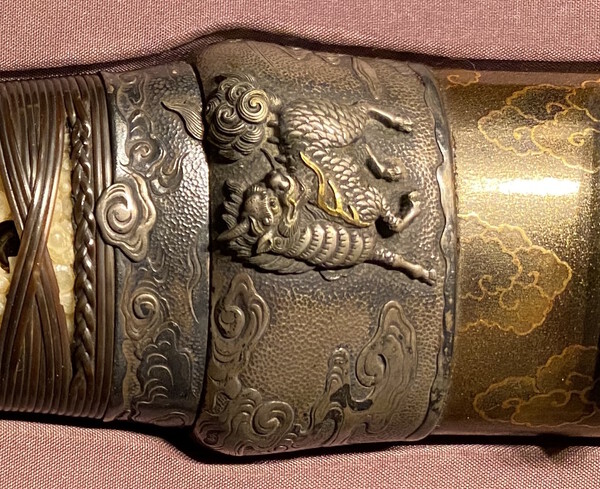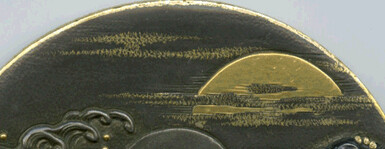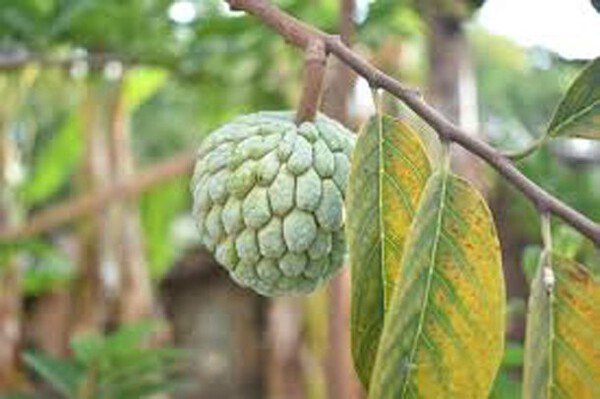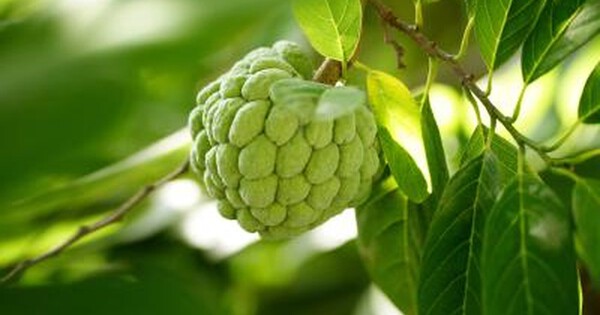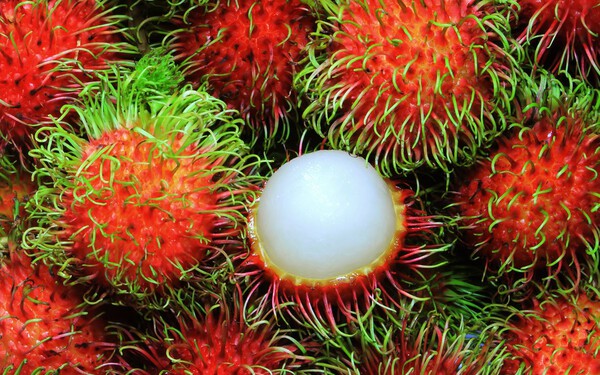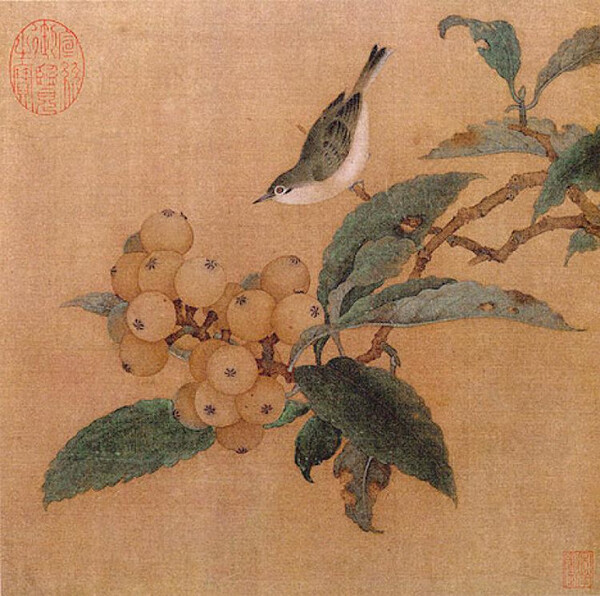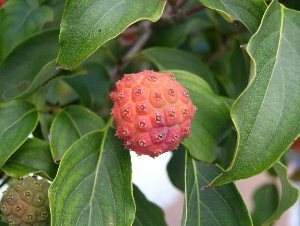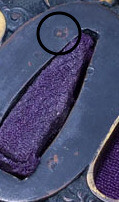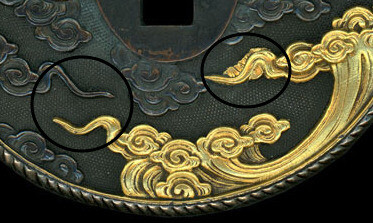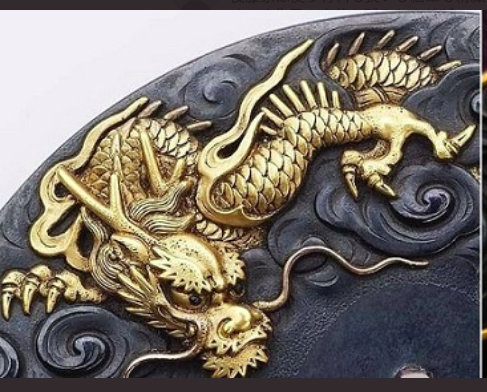-
Posts
858 -
Joined
-
Last visited
-
Days Won
7
Everything posted by Tanto54
-
Bishamonten is the god of warriors and punisher of evildoers. He is one of the shichifukujin (Seven Gods of Fortune) and is often portrayed with a yari or baton in one hand and a Stupa (a small pagoda which represents the treasure house that he guards) in the other hand. Japanese artists sometimes humorously depict Bishamon with an Oni (demon) who has stolen his pagoda.
-
Dear Ken, Would like to see a picture of the whole tsuba (unfortunately, I agree with Adam - looks cast - especially nakago-ana - in your picture...)
-
Dear Torrez, Agree with Rich - definitely Japanese. Probably from a group of manju carvers whose names follow the Sho - ___ - sai form (so just look for carvers with three kanji names and the first is Sho and the last is Sai).
-
Hi Tony, Don't know for sure whether it is Sun or Moon - but the dark waves and highlights just makes it feel like the Moon to me... Here are some clouds on tosogu and the saya.
-
-
Most Samurai Wives were expected to carry a Kaiken on their person, and it was often given to her along with nice lacquer koshirae as part of her trousseau or dowery. They are sometimes a family tanto or yari remounted in nice lacquer. Many Samurai were married, so just think how many of these were needed... Sorry to break it to you Guys, but your "badass" tanto or yari mounted as a kaiken with cherry blossoms or a family mon is probably a woman's (although a badass woman's) weapon.
-
Dale, I was hoping that you'd get involved in trying to determine what fruit this is. The monkeys and style of the menuki you posted have a lot in common with Mark's kogai (but the original poster says chestnut - back to Guido's observation that chestnut is one of the defaults). I still have not found a fruit that I'm completely satisfied with, but the following Buddha's Head Fruit/Cherimoya/Custard Apple (hybrid) looks the most like the fruit in Mark's kogai that I've been able to find. The only problem is that this fruit probably didn't come to Japan or Asia until about a hundred years ago (so probably too young for Mark's kogai...) Also, still can't explain the larger, smooth, central nodule on the fruit in Mark's kogai. Perhaps Matt's suggestion of something like the Rambutan (or Lychee, etc.) might explain that smooth nodule (see bottom photo of an open Rambutan among closed ones. Open Rambutan:
-
Dear Pete, I didn't know it was yours (but I should have suspected it - you have the nicest things...)
-
I’ve been trying to decipher this theme since Mark kindly showed me this beauty at the Atlanta Show earlier this year. I really like Guido’s suggestion of loquats and found many good pictures of that theme (monkey/saru and loquat/biwa). However, the fruit on Mark’s Kogai doesn’t look like the loquat/biwa in any of the pictures, paintings or tosogu that I saw. I know I’m taking a huge risk questioning Guido’s vast knowledge (who can forget when he taught us the difference between Shikami and Oni years ago ). Also (for those of you who have been around here for a while), I know I risk getting the famous Guido reply of a rabbit with a pancake on its head ( fear of that response is one of my greatest phobias and it makes me be very careful in every posting on the NMB…) However, in the interests of [my] learning…. The fruit on Mark’s Kogai is either a bunch of individual fruits growing together in a globe shape or a single, globe shaped fruit with a bunch of nodules. Loquats/biwa are clustered randomly and do not grow together in a globe shape. In addition, they have a distinctive calyx (the “navel” looking thing at the bottom of many fruits) that is almost alway depicted in art, but are absent on Mark’s Kogai. Similarly, the various “bulbs” on the fruit on Mark’s Kogai are pockmarked with lots of dimples (except for the central, larger one) and loquats are smooth. Therefore, I don’t think that this Kogai has loquats. So what suggestion can I offer??? I don’t really have anything more convincing. I thought it might be a dogwood fruit (Kousa or Yamaboshi - which Japanese monkeys love to eat). That fruit looks a lot more like the fruit on Mark’s Kogai, but that doesn’t explain the central, smooth and larger nodule in the center. So I think that we still haven’t identified the theme of Mark's Kogai yet. Guido-sama - what say you? MARK'S KOGAI: LOQUAT PICTURES: DOGWOOD FRUIT:
-
Dear Barry - Fukuda
-
Dear Tom, I do not see any signs of modern casting on the tsuba in the most recent link that you posted. I do understand your feelings that the carvings in the original [cast/molded] tsuba looked better than the carvings in the linked, non-cast tsuba. However, remember that the modern rubber mold [or stamped] processes can have a great difference in definition and quality (as demonstrated by some of the really bad cast copies shown in this thread). And, if someone is using one of the very high definition casting techniques to copy a well carved tsuba, the cast copy may look better (especially in pictures) than a lesser carved original tsuba.
-
Dear Robert, I don't remember ever seeing a modern cast copy with good papers, but last year, I did see a very expensive set of gold menuki that were definitely modern lost wax cast in a famous store in Tokyo (one that is often mentioned on the NMB). While the shop-owner is clearly a tosogu expert (and knows 1 million times more than me), I do not believe that he knew that the menuki were modern cast. I've also seen a few modern cast copies in famous collections. If I remember correctly, Ford Hallam told the NMB a story about meeting a member of the Japanese Royal Family who proudly showed him an "antique master-piece" tsuba which actually turned out to be a modern fake. So you do have to be careful. Ford and the artists who have experience making tosogu or casting jewelry can spot modern copies even when many tosogu experts cannot. It's just a different skill set. Having said that, I don’t want to scare people away from buying tosogu or say only buy stuff that is papered (it adds so much to the cost and you might end up missing out on some great pieces). Perhaps papers are best with really expensive items (>$10K?). Also buying from a trusted dealer or someone you know on the NMB is fairly safe (I imagine that most reputable dealers would take a modern fake back if it were discovered post-sale - but probably not on ebay or Yahoo Japan…). If you search the NMB for cast, you’ll find a number of threads with lots of information. I think that after studying the cast copies closely, you will start to pick up on the telltale signs pretty quickly.
-
One of the scary things about modern vulcanized molding and wax casting is that it can pick up very fine detail (to the level of fingerprints!) Fortunately, there are usually telltale signs of this modern process (but they are getting harder and harder to detect on the really good copies). Gold and silver is particularly easy to cast, so watch out for gold menuki and solid silver tsuba. Homogenous metal pieces (i.e., without inlay) are much easier to do and conceal. Look for bad patinas and painted on gold/silver like this one...
-
Dear Tom and Robert, Yes, the tsuba in question looks better than the others, but, in my opinion, it is just a better job of copying. I agree with Yasaka-san that this tsuba is a recent copy made by modern manufacturing techniques. Consider the following and let me know what you think. The divot on the upper left of the seppadai looks just like the divots that I've seen when sprues are broken off of castings (sprues are the channels that feed a molten metal casting and when the metal solidifies, they look like thin rods attached to the casting). Sometimes when the sprue is broken off (instead of sawn off cleanly) it creates a divot (depression) with the center being slightly raised like a reverse volcano. In each casting, the sprues are individually placed so the sprues may be in slightly different places from one casting to the next. So that's why it may look different than the other sprue marks on the other cast versions that Tom showed. Take a look at this picture and let me know if you think it might be the remnants of a sprue. In many places on the Tsuba, I see what appear to me to be casting or molding bubbles ("positive" not "negative" bubbles). The nanako appears "stretched" in some places which can happen when using wax and/or rubber in the molding process. Finally, there appears to be lots of "clean up" from faulty molding (whether cast or stamped). For example see the "blob" in the picture below (circle on the right) behind the tail of one of the clouds (there are about a dozen cloud tails on the Tsuba and only this one has the "blob" behind it - so I do not believe that it is intentional). If it were carved (instead of being cast/molded/stamped), the maker would have fixed this area. Instead, they simply painted gold over it to hide it.
-
Dear Robert, I think Yasaka-san is telling us that both tsuba in the pictures are bad... However, one of the tsuba in his Twitter link is good (IMHO):
-

Nefarious Nihonto, Bogus Blades, And The Quest for Bad Papers
Tanto54 replied to jt nesbitt's topic in Nihonto
Dear Ian, If it were 1, 2, 3 or even 5 blades, I might agree with you. But he has bought 12+ "treasure" blades that he now describes as "nefarious and bogus", and his method of study has been to plop the blades on this Board and wait to get spoon-fed information (and his sole mentor is Jay Leno...). Then when at least one turns out not so bad, he decides to resell. I can only imagine that when you made your comment, you didn't know about the 12 other purchases that he made before leaning anything... I can't agree that his approach is "exactly the right thing". I like that he wants to educate newbies by being candid about his mistakes, but do you really want to advise newbies to follow his example of "I bought it for no other reason than it was the cheapest katana with papers available at the time." Not because he loved it, or because it appealed to him - just because it had papers! How many times have we said buy the sword not the mei (or papers)? Michael, I'll give you the benefit of the doubt here too (yes, a couple of thousand dollars multiplied by 12 will get you a juyo). -

Nefarious Nihonto, Bogus Blades, And The Quest for Bad Papers
Tanto54 replied to jt nesbitt's topic in Nihonto
But JT, just think of all that time wasted driving Yugos..... Also, your theory is kind of like banging your head against the wall just because it feels so good when you stop. Actually instead of Ferraris and Yugos, it is more like saying you can't enjoy driving unless you've had a few wrecks (which isn't really true...) -

Nefarious Nihonto, Bogus Blades, And The Quest for Bad Papers
Tanto54 replied to jt nesbitt's topic in Nihonto
Dear JT, I applaud your candor and willingness to learn from your mistakes. Just think what you could have purchased if you studied a little first or got someone here to mentor you in your purchases. If you had all the money you spent on these ebay "treasures", you could probably purchase a very nice Juyo blade that would be a work of art and a true treasure. Nevertheless, if you like what you purchased, that's all that matters (but now you are selling???) -
Dear Adam (and Ned), I'm sure that your fuchi is a play or parody on Botanka Shohaku. Please see the attached parody painting by Utagawa Toyokuni (1769-1825) of a Courtesan as Botanka Shohaku. Notice the flower in the ox's harness just like your fuchi. I've also seen woodblock prints of this same subject (parody of a courtesan as Botanka Shohaku). I haven't read his poems in a long time, but many times fireflies are allusions for Samurai and the swarms of fireflies are often compared to the Genpei Wars. Fireflies are believed to be the spirits of warriors who fell in battle (a metaphor also used in the story “Grave of the Fireflies”).
-
Dear Adam, Looks like the mei matches the example in Sesko's book and I've included the Haynes entry. As for the combination of Fukurokuju and Hotaru, a possibility is that Fukurokuju was considered the embodiment of the Southern Polar Star and had the ability to raise the dead. Hotaru (fireflies) have similar connections. As for the Ox, it could be a play on the famous poet (who road around on an ox), Botanka Shohaku. Perhaps, you could research whether he wrote a poem about fireflies.
-
Welcome Adam & Ned!
-
Dear Adam, Welcome and excellent research! I wish all first time posters tried as hard as you to find out more about their treasures before posting. To assist you along the way in additional research, the bug is a firefly (hotaru) instead of a hornet. The "driver" of the ox is Fukurokuju (one of the Seven Gods of Fortune).
-
In my opinion (for whatever that's worth...), this is very nice lacquer (not made for tourist trade). A samurai woman would have carried this inside the lapel of her kimono for protecting herself and her "honor". That explains the hardware (which is nice but worn) - it is sometimes called a kaiken. The fine details of the lacquer have been worn away smooth in some places where it rubbed against the silk kimono from daily wearing. As you may know, lacquer is sensitive to UV and will darken when exposed too much. Fixing fine lacquer [properly] is almost always cost prohibitive and usually undertaken only on pieces in the five figure range (you may be able to find some craftsmen outside Japan to do it inexpensively, but I've never seen an inexpensive job that looked good...). Some museums use glues to try to stabilize the broken lacquer (but it usually doesn't look very good either). In about 50 years, I've seen about 10 of these mounted for this purpose (however, I've seen a lot more yari mounted as tanto for men).
-
Dear Bruno, Yes, the seppa wouldn't sit right would it? The interesting way you've mounted it in the last two pictures makes me wonder if there is a hidden shunga meaning with the nakagoana placement vis-a-vis Daikokuten...
-
Many tsuba have a design that encroaches on the seppadai, and having some of the design hidden by the seppa when mounted is actually considered a nice artistic touch. However, the encroaching design should always be "below the ground" so that the seppa can sit properly. I can't tell from the pictures here, but it appears that some of the encroaching design is "above the ground" such that it would cause the seppa to sit at an angle or wobble when mounted. Is Hotei's sack and Fukurokuju's shoulder higher than the cloud ground on the opposite side of the nakagoana? If so, then it probably would have to be considered a nice sculpture rather than a tsuba.





